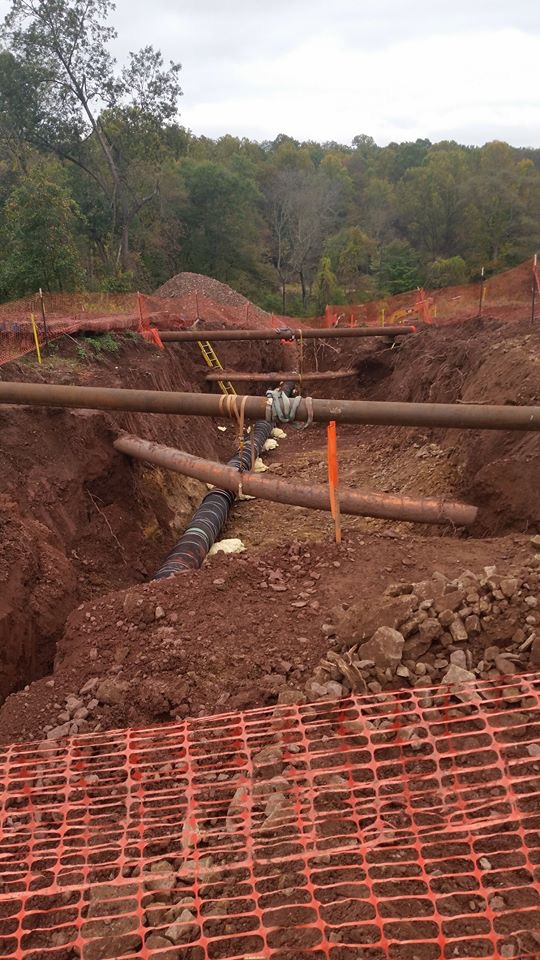by Jerry and Nancy McMullen
Sunoco Logistics Partners has status as a public utility. This enabled them to use
eminent domain to coerce us and others throughout the state to sign easements for
construction of Mariner East pipelines. These pipelines are scheduled to pass
through our property, disrupting our lives, destroying our landscape, and posing
chronic danger. Although our concern is personal, it is important that everyone
living along or traveling in proximity to these pipelines understands their risks.
Sunoco’s new pipelines are slated to follow the path of an existing pipeline installed
during the early 1930s when the majority of Chester County was farmland. In a
two-mile stretch through the heart of Exton, residential neighborhoods, retail
centers, Meadowbrook Manor Little League Field, Chester County Library, Exton
Elementary School, Sunrise Senior Living Facility, AMTRAC/SEPTA rail lines, routes
100 and 30, and a stream and wetlands will fall within the Mariner pipelines’ impact
zone. The potential danger for this densely developed area is exceptional and
deserves careful consideration.
OVERVIEW OF MARINER EAST PIPELINES
The purpose of Mariner East pipelines is to transport propane, ethane, butane, and
other liquefied hydrocarbons from the Marcellus and Utica shale regions of Ohio,
West Virginia, and Western Pennsylvania to Sunoco’s facility in Marcus Hook. The
gas and oil industry refers to liquefied hydrocarbons as natural gas liquids (NGLs).
The federal government, however, classifies these products as “hazardous, highly
volatile liquids.” NGLs are liquid only under very high pressure or extremely cold
temperatures. If a leak occurs, NGLs escape into the atmosphere as colorless,
odorless gases that are heavier than air, extremely flammable or explosive, and
asphyxiating.

MARINER EAST 1
ME1 is an 8-inch diameter steel pipeline whose original use was moving petroleum
products 300 miles from Sunoco’s oil refinery in Marcus Hook to markets in
Western Pennsylvania. During 2014, ME1 was converted to carry 70,000 barrels of
NGLs per day to the repurposed Marcus Hook facility for storage, processing, and
distribution.
MARINER EAST 2
During December 2013, Sunoco announced plans for ME2, a 350-mile 20-inch
diameter pipeline that spans Pennsylvania and parts of West Virginia and Ohio.
Initial capacity of this pipeline will be approximately 275,000 barrels of NGLs per
day, with a maximum capacity of 450,000 barrels daily.
Perils of the Pipelines 2
MARINER EAST 2X
Mariner East 2X (ME2X) is another new pipeline included in Sunoco’s plans. This
16-inch diameter pipeline has the potential of transporting 250,000 barrels of NGLs
daily.
SUMMARY OF MARINER EAST PIPELINES’ CAPACITY
The volume of an oil barrel is 42 gallons. The following chart shows the quantity of
NGLs moving through Pennsylvania if Sunoco’s three pipelines operate at full
capacity. Most of these materials are intended for export to European
petrochemical manufacturers.
Daily Capacity of Mariner East Pipelines
Pipeline Diameter Barrels Gallons
Mariner 1 8-inch 70,000 2,940,000
Mariner 2 20-inch 450,000 18,900,000
Mariner 2X 16-inch 250,000 10,500,000
TOTAL 770,000 32,340,000
WHO IS AT RISK?
According to written testimony by Middletown Coalition for Community Safety
(November 2016), a pipe containing NGLs that leaks and explodes creates a blast
zone of approximately 1100-1500 feet, with thermal impacts (such as severe burns
or property damage) up 2200-3000 feet. FracTracker (December 2017) estimates
that 105,419 Pennsylvanians live within Mariner East’s blast zone; almost one-third
of these residents live in Chester County. The table below rank orders the five
Pennsylvania counties whose populations are most at risk.
Residents within the Blast Zone of
Mariner East Pipelines
Rank County Number of residents
1 Chester 31,632
2 Delaware 17,791
3 Westmoreland 11,183
4 Cumberland 10,498
5 Berks 10,498
Further highlighting local vulnerability, FracTracker found that thirteen (32.5%) of
the 40 Pennsylvania public and private schools that lie within the Mariner East’s
thermal impact zone are located in Chester County.
Perils of the Pipelines 3
CONCLUSION
Governor Wolf and Pennsylvania’s regulatory agencies, including the Public Utility
Commission and the Department of Environmental Protection, have not been
diligent enough in oversight of Sunoco’s practices during Mariner East pipeline
planning and installation. Sunoco has violated regulations and agreements,
damaged homes, created sinkholes, contaminated aquifers and wells, and disrupted
wetlands. The danger of major explosions looms as millions of gallons of hazardous,
highly volatile liquids flow near homes, businesses, schools, and recreation facilities
on a daily basis. No county is more at risk than Chester County. It is necessary to
be informed, vigilant, and proactive to assure the safety and well being of our
community.